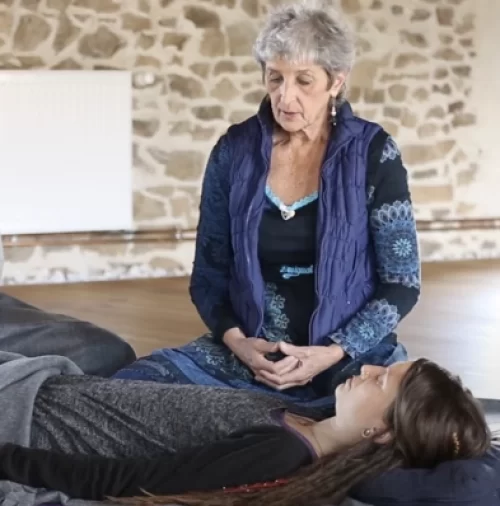CONSCIOUS BREATHING FOR TRAUMA RECOVERY (CBTR)
Free online conscious breathing education that is both simple and effective

The CBTR training has been created by Brigitte Martin Powell and Judee Gee, breath specialists and breathwork trainers based in the UK and in France. Judee and Brigitte are former Presidents of the IBF. At the time of developing this programme they were sitting on the IBF-UN working group committee which develops Conscious Breathing projects in alignment with the United Nations 2030 Agenda for Sustainable Development.
The CBTR programme was originally designed for refugees, migrants and victims of natural disasters as well as health care workers, staff and volunteers of relief organisations.
It has been now extended to include anyone suffering from trauma, anxiety, burnout and depression.
The goal of the CBTR programme is to provide free online conscious breathing education that is both simple and effective through:
- Giving practical instructions for developing an awareness of current breathing habits
- Teaching specific breathing exercises to recalibrate the autonomic nervous system
What is coherent breathing
Coherent Breathing and the Autonomic Nervous System
Głównym składnikiem układu odpowiedzi na stres jest autonomiczny układ nerwowy, który zarządza automatycznymi funkcjami organizmu, w tym układu sercowo-naczyniowego, oddechowego, pokarmowego, hormonalnego, gruczołowego i układu odpornościowego. Autonomiczny układ nerwowy ma dwie główne gałęzie: współczulny układ nerwowy – układ walki lub lotu – i przywspółczulny układ nerwowy – reszta i trawić lub karmić i hodować– system.
Idealnie, oba systemy są zobowiązane do interwencji w konkretnych działaniach w naszym codziennym życiu, ale w dłuższej perspektywie konieczna jest równowaga między nimi. Ciało, które jest stale pod wpływem stresu psychicznego, fizycznego lub emocjonalnego (układ współczulny) bez czasu na odpoczynek, integrację i uzupełnianie (układ przywspółczulny), nie będzie w stanie funkcjonować optymalnie i poniesie konsekwencje.

There is one automatic function of the body that can be voluntarily controlled through our breath and that is the respiratory system! Świadome techniki oddychania zapewniają łatwy dostęp do autonomicznej sieci komunikacyjnej, a zmieniając nasze wzorce oddychania, wysyłamy konkretne wiadomości do mózgu, które mają potężny wpływ na nasze myśli, emocje i zachowania. Na przykład, kiedy czujemy niepokój, zaledwie kilka minut spójnego oddychania może uspokoić nasz zmartwiony umysł i sprzyjać bardziej racjonalnemu – a nie impulsywnemu – podejmowaniu decyzji.
Spójna praktyka oddychania: Oddychanie w rytmie 5 oddechów na minutę jest optymalnym rytmem oddechowym do przywrócenia równowagi ciała i uzyskania dostępu do wewnętrznego stanu relaksu, który jest zarówno spokojny, jak i spokojny. Pięć oddechów na minutę odpowiada wdychaniu przez 6 sekund i na 6 sekund, łącząc oddech i oddech w zrelaksowany sposób.
Jak ćwiczyć: Zacznij stopniowo, oddychając świadomie i zrelaksowany przez 3 sekundy i 3 sekundy, aż poczuje się komfortowo. Następnie przejdź do oddychania przez 4 sekundy i 4 sekundy i postępuj we własnym rytmie do 6 sekund i 6 sekund. Wyżsi ludzie mogą chcieć oddychać wolniej.
Gdzie ćwiczyć: Zacznij od znalezienia spokojnego miejsca, w którym możesz być niezakłócony przez kilka minut. Miękkie warunki świetlne lub ciemność pomogą Ci się zrelaksować. Mieć lekki koc pod ręką, aby upewnić się, że pobyt ciepły. Usiąść lub położyć się w wygodnej pozycji i rozpocząć praktykę. Gdy poczujesz się komfortowo z praktyką, możesz zastosować ją w wielu sytuacjach (siedzenie, chodzenie…).
Kiedy ćwiczyć: Trzy razy dziennie przez pięć minut (365) to świetny początek, a jeśli możesz stosować praktykę codziennie przez kilka tygodni, będziesz czerpać największe korzyści. Nawet jedna minuta spójnego oddychania pomoże zrównoważyć układ nerwowy. Stephen Elliot sugeruje 20 min dziennie przez okres 21 dni w celu ponownej kalibracji układu nerwowego i zainstalowania spójnego odruchu oddechowego jako domyślnej praktyki.
The CBTR training has been created by Brigitte Martin Powell and Judee Gee, breath specialists and breathwork trainers based in the UK and in France. Judee and Brigitte are former Presidents of the IBF. At the time of developing this programme they were sitting on the IBF-UN working group committee which develops Conscious Breathing projects in alignment with the United Nations 2030 Agenda for Sustainable Development.
CBTR VIDEOS
Watch the trailer:
Watch the Presentation:
Watch the Demonstration:
Credits
Thanks to the IBF Development Fund for funding the development of the CBTR training programme in Athens, Greece.
THE CBTR MANUALS
THE IBF BREATHING APP
This free app is the perfect tool to practice the CBTR Program – and much more.
It is now available for free for iPhones on the Apple Store and for Androids on the Google Play Store. The name of the app is IBF Breathing App.
If you want to get more detailed information about the IBF Breathing app, click here:

For more information about Coherent Breathing
Keywords for Internet search
Świadome oddychanie
Oddychanie
Coherent Breathing
Stephen Elliott
Sympathetic and Parasympathetic Nervous System
Heart Rate Variability (HRV)
Zastrzeżenie
This presentation is designed to provide helpful guidance for recovering from trauma and reinforcing natural resiliency, but should not be used to diagnose or treat any health or medical conditions requiring medical supervision.
The publisher and authors are not liable for any consequences from the application by any person using the information provided in the presentation. Even though conscious breathing is simple and safe, some may find this method challenging, and are encouraged to consult a conscious breathing specialist in order to progress in the practice.